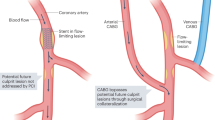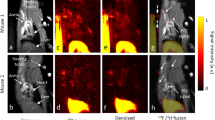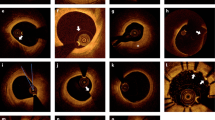Abstract
Inflammation within atherosclerotic plaques is one of the main drivers of atherosclerotic plaque rupture, which frequently leads to clinical events such as myocardial infarction and stroke. Current gold standard techniques such as X-ray angiography and ultrasound can rapidly report on luminal encroachment but give no readout on inflammatory state of the plaque. We summarize several alternative imaging techniques—CT, MRI, and nuclear imaging—that are close to the clinical arena, and we provide the relative advantages of each.
Key Points
-
Inflammation within atherosclerotic plaques is the main force behind plaque rupture and clinical events
-
There is no perfect imaging technique; each modality has advantages and disadvantages in terms of resolution, sensitivity, and radiation exposure
-
MRI, CT, and nuclear imaging techniques can quantify the level of inflammation within atherosclerotic plaques
-
Long-term, prospective, clinical outcome studies are required to prove the capacity of imaging to predict those patients who will have events in the future
This is a preview of subscription content, access via your institution
Access options
Subscribe to this journal
Receive 12 print issues and online access
$209.00 per year
only $17.42 per issue
Buy this article
- Purchase on Springer Link
- Instant access to full article PDF
Prices may be subject to local taxes which are calculated during checkout



Similar content being viewed by others
References
Davies MJ (1996) Stability and instability: two faces of coronary atherosclerosis. Circulation 94: 2013–2020
Davies MJ (1995) Acute coronary thrombosis—the role of plaque disruption and its initiation and prevention. Eur Heart J 16 (Suppl L): S3–S7
Jaffer FA et al. (2007) Molecular imaging of cardiovascular disease. Circulation 116: 1052–1061
Wu JC et al. (2007) Cardiovascular molecular imaging. Radiology 244: 337–355
Fayad ZA and Fuster V (2001) The human high-risk plaque and its detection by magnetic resonance imaging. Am J Cardiol 88 (Suppl 1): 42E–45E
Itskovich V et al. (2004) Quantification of human atherosclerotic plaques using spatially enhanced cluster analysis of multicontrast-weighted magnetic resonance images. Magn Reson Med 52: 515–523
Yuan C et al. (2002) Identification of fibrous cap rupture with magnetic resonance imaging is highly associated with recent transient ischemic attack or stroke. Circulation 105: 181–185
Yuan C et al. (2001) In vivo accuracy of multispectral magnetic resonance imaging for identifying lipid-rich necrotic cores and intraplaque hemorrhage in advanced human carotid plaques. Circulation 104: 2051–2056
Tang TY et al. (2008) Correlation of carotid atheromatous plaque inflammation with biomechanical stress: utility of USPIO enhanced MR imaging and finite element analysis. Atherosclerosis 196: 879–887
Trivedi RA et al. (2006) Identifying inflamed carotid plaques using in vivo USPIO-enhanced MR imaging to label plaque macrophages. Arterioscler Thromb Vasc Biol 26: 1601–1606
Trivedi RA et al. (2004) In vivo detection of macrophages in human carotid atheroma: temporal dependence of ultrasmall superparamagnetic particles of iron oxide-enhanced MRI. Stroke 35: 1631–1635
Trivedi R et al. (2003) Accumulation of ultrasmall superparamagnetic particles of iron oxide in human atherosclerotic plaque. Circulation 108: e140
Rioufol G et al. (2002) Multiple atherosclerotic plaque rupture in acute coronary syndrome: a three-vessel intravascular ultrasound study. Circulation 106: 804–808
Buffon A et al. (2002) Widespread coronary inflammation in unstable angina. N Engl J Med 347: 5–12
Smith BR et al. (2007) Localization to atherosclerotic plaque and biodistribution of biochemically derivatized superparamagnetic iron oxide nanoparticles (SPIONs) contrast particles for magnetic resonance imaging (MRI). Biomed Microdev 9: 719–727
Amirbekian V et al. (2007) Detecting and assessing macrophages in vivo to evaluate atherosclerosis noninvasively using molecular MRI. Proc Natl Acad Sci USA 104: 961–966
Weustink AC et al. (2007) Reliable high-speed coronary computed tomography in symptomatic patients. J Am Coll Cardiol 50: 786–794
Pohle K et al (2007) Characterization of non-calcified coronary atherosclerotic plaque by multi-detector row CT: comparison to IVUS. Atherosclerosis 190: 174–180
Carrascosa PM et al. (2006) Characterization of coronary atherosclerotic plaques by multidetector computed tomography. Am J Cardiol 97: 598–602
Leber AW et al. (2004) Accuracy of multidetector spiral computed tomography in identifying and differentiating the composition of coronary atherosclerotic plaques: a comparative study with intracoronary ultrasound. J Am Coll Cardiol 43: 1241–1247
Hoffmann U et al. (2006) Noninvasive assessment of plaque morphology and composition in culprit and stable lesions in acute coronary syndrome and stable lesions in stable angina by multidetector computed tomography. J Am Coll Cardiol 47: 1655–1662
Leber AW et al. (2003) Composition of coronary atherosclerotic plaques in patients with acute myocardial infarction and stable angina pectoris determined by contrast-enhanced multislice computed tomography. Am J Cardiol 91: 714–718
Hyafil F et al. (2007) Noninvasive detection of macrophages using a nanoparticulate contrast agent for computed tomography. Nat Med 13: 636–641
Shankar LK et al. (2006) Consensus recommendations for the use of 18F-FDG PET as an indicator of therapeutic response in patients in National Cancer Institute Trials. J Nucl Med 47: 1059–1066
Weber WA and Figlin R (2007) Monitoring cancer treatment with PET/CT: does it make a difference? J Nucl Med 48 (Suppl 1): S36–S44
Rudd JH et al. (2002) Imaging atherosclerotic plaque inflammation with [18F]-fluorodeoxyglucose positron emission tomography. Circulation 105: 2708–2711
Stefanadis C et al. (2001) Increased local temperature in human coronary atherosclerotic plaques: an independent predictor of clinical outcome in patients undergoing a percutaneous coronary intervention. J Am Coll Cardiol 37: 1277–1283
Tawakol A et al. (2006) In vivo 18F-fluorodeoxyglucose positron emission tomography imaging provides a noninvasive measure of carotid plaque inflammation in patients. J Am Coll Cardiol 48: 1818–1824
Dunphy MP et al. (2005) Association of vascular 18F-FDG uptake with vascular calcification. J Nucl Med 46: 1278–1284
Davies JR et al. (2005) Identification of culprit lesions after transient ischemic attack by combined 18F fluorodeoxyglucose positron-emission tomography and high-resolution magnetic resonance imaging. Stroke 36: 2642–2647
Tahara N et al. (2006) Simvastatin attenuates plaque inflammation: evaluation by fluorodeoxyglucose positron emission tomography. J Am Coll Cardiol 48: 1825–1831
Virmani R et al. (2006) Histopathology of carotid atherosclerotic disease. Neurosurgery 59 (Suppl 3): S219–S227
Ishino S et al. (2007) 99mTc-Annexin A5 for noninvasive characterization of atherosclerotic lesions: imaging and histological studies in myocardial infarction-prone Watanabe heritable hyperlipidemic rabbits. Eur J Nucl Med Mol Imaging 34: 889–899
Johnson LL et al. (2005) 99mTc-annexin V imaging for in vivo detection of atherosclerotic lesions in porcine coronary arteries. J Nucl Med 46: 1186–1193
Isobe S et al. (2006) Noninvasive imaging of atherosclerotic lesions in apolipoprotein E-deficient and low-density-lipoprotein receptor-deficient mice with annexin A5. J Nucl Med 47: 1497–1505
Kietselaer BL et al. (2004) Noninvasive detection of plaque instability with use of radiolabeled annexin A5 in patients with carotid-artery atherosclerosis. N Engl J Med 350: 1472–1473
Hartung D et al. (2005) Resolution of apoptosis in atherosclerotic plaque by dietary modification and statin therapy. J Nucl Med 46: 2051–2056
Sarda-Mantel L et al. (2006) 99mTc-annexin-V functional imaging of luminal thrombus activity in abdominal aortic aneurysms. Arterioscler Thromb Vasc Biol 26: 2153–2159
Galis ZS et al. (1994) Increased expression of matrix metalloproteinases and matrix degrading activity in vulnerable regions of human atherosclerotic plaques. J Clin Invest 94: 2493–2503
Luan Z et al. (2003) Statins inhibit secretion of metalloproteinases-1, -2, -3, and -9 from vascular smooth muscle cells and macrophages. Arterioscler Thromb Vasc Biol 23: 769–775
Schafers M et al. (2004) Scintigraphic imaging of matrix metalloproteinase activity in the arterial wall in vivo. Circulation 109: 2554–2559
Breyholz HJ et al. (2007) A 18F-radiolabeled analogue of CGS 27023A as a potential agent for assessment of matrix-metalloproteinase activity in vivo. Q J Nucl Med Mol Imaging 51: 24–32
Author information
Authors and Affiliations
Corresponding author
Ethics declarations
Competing interests
The authors declare no competing financial interests.
Rights and permissions
About this article
Cite this article
Rudd, J., Fayad, Z. Imaging atherosclerotic plaque inflammation. Nat Rev Cardiol 5 (Suppl 2), S11–S17 (2008). https://doi.org/10.1038/ncpcardio1160
Received:
Accepted:
Issue Date:
DOI: https://doi.org/10.1038/ncpcardio1160
This article is cited by
-
Soluble low-density lipoprotein receptor-related protein 1 as a surrogate marker of carotid plaque inflammation assessed by 18F-FDG PET in patients with a recent ischemic stroke
Journal of Translational Medicine (2023)
-
SPECT/CT Imaging of High-Risk Atherosclerotic Plaques using Integrin-Binding RGD Dimer Peptides
Scientific Reports (2015)
-
Targeted Nanoparticles for Cardiovascular Molecular Imaging
Current Radiology Reports (2013)
-
FDG PET Imaging and Cardiovascular Inflammation
Current Cardiology Reports (2011)
-
Early identification of atherosclerotic disease by noninvasive imaging
Nature Reviews Cardiology (2010)



